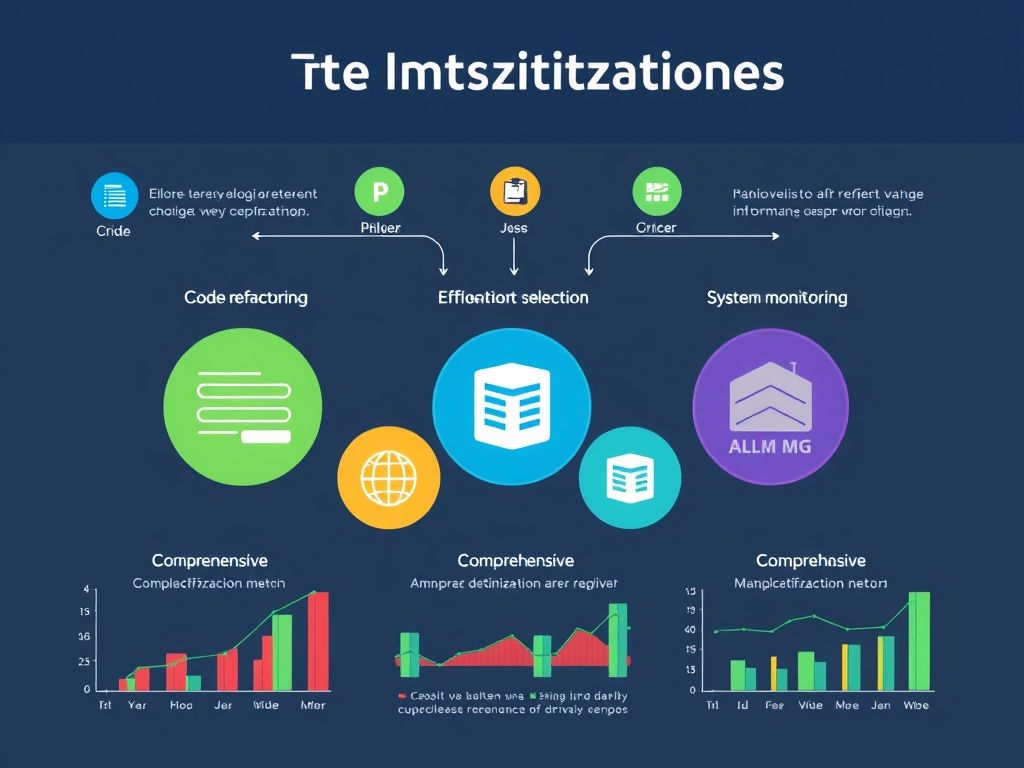System optimization is crucial for smooth operation and enhanced performance. This article provides practical tips and strategies for optimizing your systems, covering programming techniques and maintenance strategies. Learn how to boost efficiency, reduce errors, and improve overall system stability.
Understanding System Optimization
System optimization is the art and science of making computer systems operate more efficiently. This involves a multifaceted approach that addresses both the underlying code and the operational environment. At its core, system optimization aims to reduce resource consumption, improve response times, and enhance overall system stability. The importance of system optimization cannot be overstated, especially in today’s resource-intensive computing landscape.
One of the fundamental aspects of system optimization is **efficient coding practices**. The way code is written directly impacts the performance of the system. Poorly written code can lead to unnecessary resource usage, such as excessive memory allocation or inefficient algorithms, which can significantly slow down the system. Conversely, well-crafted code can execute faster, consume fewer resources, and improve the overall responsiveness of the system. This directly relates to *Tip lập trình*, or programming tips, which emphasize writing clean, efficient, and optimized code.
Consider the following elements of efficient coding practices:
- Algorithm Selection: Choosing the right algorithm for a particular task can drastically reduce the time complexity of the operation. For example, using a binary search algorithm instead of a linear search for a sorted dataset can significantly improve search times.
- Data Structures: Selecting appropriate data structures is crucial. Using a hash table for quick lookups or a linked list for dynamic memory allocation can optimize memory usage and access times.
- Code Profiling: Identifying performance bottlenecks in the code is essential. Tools like profilers can help pinpoint areas where the code is consuming the most resources, allowing developers to focus their optimization efforts effectively.
- Memory Management: Efficient memory management is vital to prevent memory leaks and reduce garbage collection overhead. Proper allocation and deallocation of memory can significantly improve system performance.
Another critical component of system optimization is the role of maintenance in preventing performance degradation. Systems, like any complex machinery, require regular maintenance to ensure they continue to operate at peak efficiency. Neglecting maintenance can lead to a gradual decline in performance over time.
**Duy trì mã nguồn**, or source code maintenance, plays a significant role in this. Regular code reviews, updates, and refactoring can help identify and address potential performance issues before they become major problems. This also includes keeping the codebase clean, well-documented, and easy to understand, which facilitates future optimizations and improvements.
The benefits of system optimization are numerous and far-reaching. Improved performance translates to faster response times, increased throughput, and a better user experience. Reduced resource consumption leads to lower operating costs and increased energy efficiency. Enhanced system stability results in fewer crashes and downtime, improving overall reliability.
Furthermore, understanding the various aspects of system optimization involves considering different levels of optimization, from hardware configurations to software architectures. Optimizing at the hardware level might involve upgrading components like CPUs, RAM, or storage devices. Optimizing at the software level could include tuning operating system settings, optimizing database queries, or improving network configurations.
**Tối ưu hóa hệ thống**, or system optimization, requires a holistic approach that considers all aspects of the system. This includes:
- Hardware Optimization: Upgrading or reconfiguring hardware components to improve performance.
- Software Optimization: Tuning operating system settings, optimizing database queries, and improving network configurations.
- Code Optimization: Writing efficient code, selecting appropriate algorithms and data structures, and profiling code to identify performance bottlenecks.
- Maintenance and Monitoring: Regularly reviewing code, updating software, and monitoring system performance to identify and address potential issues.
In summary, system optimization is an ongoing process that requires a deep understanding of both the hardware and software aspects of a system. By focusing on efficient coding practices, regular maintenance, and a holistic approach to optimization, it is possible to unlock significant performance gains and ensure the long-term stability and reliability of the system. This understanding will be crucial as we delve into specific Programming Tips for Optimized Systems in the next chapter.
Chapter 2: Programming Tips for Optimized Systems
Building upon the foundation of *understanding system optimization* from the previous chapter, which highlighted the importance of efficient coding practices, this chapter delves into practical **tip lập trình** for creating optimized systems. We’ll explore how to write code that not only functions correctly but also executes efficiently, is easy to maintain, and delivers optimal performance.
One fundamental aspect of **tối ưu hóa hệ thống** is the selection and implementation of appropriate data structures and algorithms. Choosing the right data structure can significantly impact the performance of your code. For instance, if you need to frequently search for elements, a hash table or a balanced tree might be more efficient than a simple list. Similarly, for sorting large datasets, algorithms like merge sort or quicksort generally outperform simpler algorithms like bubble sort.
Consider this example in Python:
“`python
# Inefficient search in a list
def search_list(my_list, target):
for item in my_list:
if item == target:
return True
return False
# Efficient search in a set
def search_set(my_set, target):
return target in my_set
“`
While both functions achieve the same goal, the `search_set` function, which uses a set (a hash table implementation), offers significantly faster search times, especially for large datasets. This simple example illustrates the power of choosing the right data structure.
Another crucial element in writing optimized code is minimizing unnecessary computations and memory allocations. Avoid creating temporary objects if they are not needed and reuse existing objects whenever possible. String concatenation, for example, can be surprisingly inefficient in some languages if not handled carefully. In Java, using `StringBuilder` for building strings is generally much faster than using the `+` operator repeatedly.
Here’s a Java example:
“`java
// Inefficient string concatenation
String result = “”;
for (int i = 0; i < 1000; i++) {
result += "data";
}
// Efficient string concatenation
StringBuilder sb = new StringBuilder();
for (int i = 0; i < 1000; i++) {
sb.append("data");
}
String result = sb.toString();
```
The `StringBuilder` approach avoids creating numerous intermediate string objects, resulting in significant performance gains.
Furthermore, understanding the underlying hardware and operating system can lead to further optimizations. For example, taking advantage of multi-threading or asynchronous operations can improve performance on multi-core processors. Profiling tools can help identify bottlenecks in your code, allowing you to focus your optimization efforts on the areas that will have the greatest impact.
Beyond performance, **duy trì mã nguồn** is equally important. Clean, well-documented code is easier to understand, debug, and maintain over time. Use meaningful variable names, write clear comments, and follow consistent coding conventions. Refactor your code regularly to improve its structure and readability. Consider using design patterns to address common programming problems in a reusable and maintainable way.
For example, consider the following refactoring in JavaScript:
```javascript
// Original code (less maintainable)
function processData(data, type) {
if (type === 'A') {
// Process data in way A
} else if (type === 'B') {
// Process data in way B
} else {
// Default processing
}
}
// Refactored code (more maintainable using a strategy pattern)
const processingStrategies = {
'A': (data) => { /* Process data in way A */ },
‘B’: (data) => { /* Process data in way B */ },
‘default’: (data) => { /* Default processing */ }
};
function processData(data, type) {
const strategy = processingStrategies[type] || processingStrategies[‘default’];
strategy(data);
}
“`
The refactored code utilizes a strategy pattern, making it easier to add new processing types without modifying the core `processData` function. This enhances maintainability and reduces the risk of introducing bugs.
In summary, writing optimized code involves a combination of careful algorithm and data structure selection, efficient resource management, and a commitment to code maintainability. By applying these **tip lập trình**, you can create systems that are not only fast and efficient but also robust and easy to maintain. This sets the stage for the next chapter, which will discuss *maintaining optimized systems* and ensuring long-term performance.
Chapter: Maintaining Optimized Systems
Maintaining an optimized system is an ongoing process, not a one-time event. After implementing *programming tips* and optimization techniques, the real challenge lies in ensuring that the system continues to perform efficiently over time. This requires a proactive approach to code maintenance, monitoring, and continuous improvement. The goal is to prevent performance degradation and adapt to evolving requirements.
One of the primary aspects of maintaining optimized systems is consistent **code maintenance**. Well-maintained code is easier to understand, debug, and modify, which directly impacts system performance. Regular code reviews are essential to identify potential issues early on. These reviews should focus on code clarity, adherence to coding standards, and the identification of inefficient algorithms or data structures.
Another key element is establishing a robust monitoring system. Real-time monitoring of system performance metrics, such as CPU usage, memory consumption, disk I/O, and network latency, is crucial. By tracking these metrics, you can identify performance bottlenecks and areas that require further optimization. Tools like Prometheus, Grafana, and New Relic can be invaluable in this process. Setting up alerts for critical performance thresholds allows for immediate intervention when issues arise.
Identifying bottlenecks is a critical step in **tối ưu hóa hệ thống**. Performance bottlenecks can manifest in various forms, such as slow database queries, inefficient algorithms, or resource contention. Profiling tools can help pinpoint the exact location of these bottlenecks within the code. Once identified, these bottlenecks need to be addressed with targeted optimization techniques. This might involve rewriting code, optimizing database queries, or upgrading hardware.
Implementing improvements is an iterative process. After identifying and addressing bottlenecks, it’s important to measure the impact of the changes. This involves running performance tests and comparing the results to the baseline performance. If the improvements are not satisfactory, further optimization may be required. This cycle of monitoring, identifying, and improving should be continuous.
Maintaining code quality is also paramount for long-term system optimization. Code quality directly affects maintainability, scalability, and performance. Adhering to coding standards, writing unit tests, and using static analysis tools can help ensure code quality. Refactoring code regularly to improve its structure and readability is also essential.
Here are some actionable steps for maintaining code quality and performance over time:
- Regular Code Reviews: Conduct regular code reviews to identify potential issues and ensure adherence to coding standards.
- Performance Monitoring: Implement real-time monitoring of system performance metrics to identify bottlenecks.
- Profiling: Use profiling tools to pinpoint the exact location of performance bottlenecks within the code.
- Automated Testing: Write unit tests and integration tests to ensure code quality and prevent regressions.
- Code Refactoring: Regularly refactor code to improve its structure, readability, and performance.
- Dependency Management: Keep dependencies up-to-date and manage them carefully to avoid conflicts and security vulnerabilities.
- Documentation: Maintain clear and up-to-date documentation to facilitate understanding and maintenance of the code.
Effective **duy trì mã nguồn** involves not only fixing bugs and adding new features but also proactively addressing potential performance issues. This includes optimizing algorithms, reducing memory usage, and improving concurrency. Regularly reviewing and updating the codebase ensures that it remains efficient and scalable.
In the previous chapter, we discussed *programming tips* for optimizing code, including the use of appropriate data structures and algorithms. These tips are essential for building performant systems from the outset. However, even with the best initial design, systems can degrade over time due to factors such as increasing data volumes, evolving user requirements, and changes in the underlying infrastructure. Therefore, ongoing maintenance and optimization are crucial.
By implementing these strategies, you can ensure that your system remains optimized and continues to deliver high performance over time. This proactive approach to maintenance is essential for maximizing the value of your software and ensuring its long-term success.
Conclusions
By understanding and implementing optimization techniques, you can significantly improve system performance. This article offers valuable insights and actionable tips to enhance your system’s efficiency. Start applying these strategies today to unlock the full potential of your systems.











